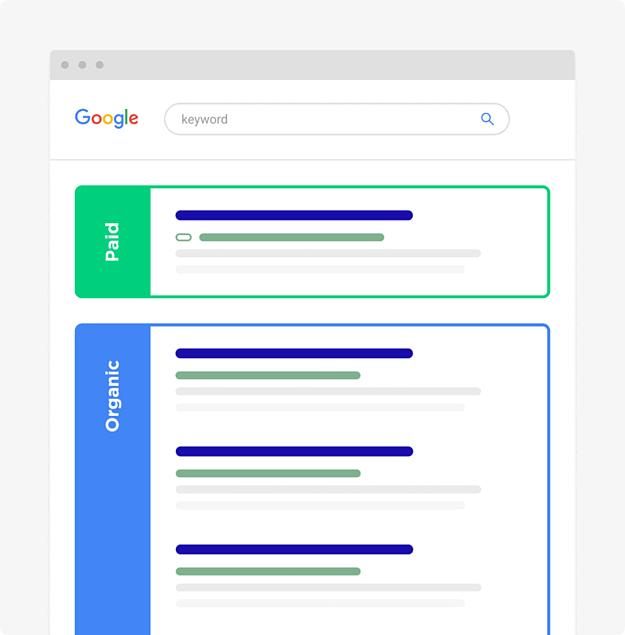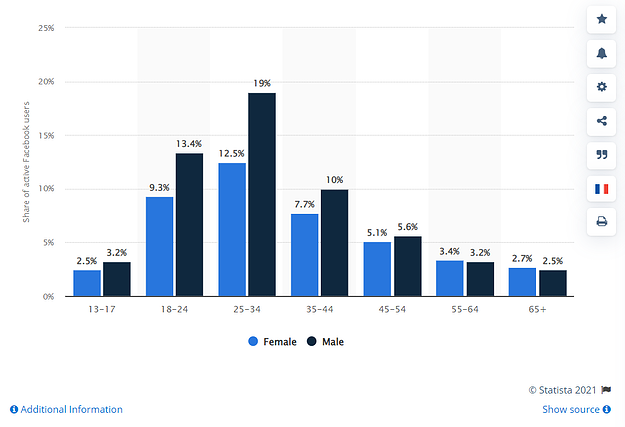Google Ads vs. Facebook Ads: Which Is Better For Your Business? 


That is the BIG question, particularly for businesses who are looking to grow their presence online.
If you’re running a digital marketing campaign, at some point or another you’ll find yourself asking the inevitable: which paid advertising platform do I use?
Do you opt for Google Ads to push your business to the top of search results on the world’s biggest website?
Or do you try to tap into Facebook’s almost 3 billion-strong active user network?
Truth be told, both platforms are insanely powerful. But there is no one-size-fits-all when it comes to the best one for your business.
It all boils down to your budget, goals, and audience — and that’s what we’re here to help you figure out.
In this post, you’ll learn everything you need to know about these two platforms, including:
- The difference between Google Ads and Facebook Ads
- The benefits of running ads on Google
- The benefits of promoting your business on Facebook
- What you need to consider when choosing between the two
And, by the end of it, you’ll know exactly how to figure out which paid ads platform is best for your business.
Ready? Let’s jump in.
What is the difference between Google Ads and Facebook Ads?
Although Facebook Ads and Google Ads (formerly Google AdWords) are both advertising platforms, they’re very different in terms of what they do and how they work. Before we talk about the benefits of both and which one to choose, it’s important to understand the key differences that set each apart.
Paid search vs. paid social
The biggest difference between Google Ads and Facebook Ads is that one (Google) is a paid search platform and the other (Facebook) is a paid social platform.
Google Ads is a pay-per-click advertising platform (PPC platform) that allows you to put your business at the top of Google search results — even above the organic search results.

Image credit: Backlinko
Google Ads works on an auction model, which means you ‘bid’ to show up for specific keywords that potential customers might be searching for. If you win, you’ll show up in search results. Then when a user clicks on your ad, you’ll be charged the amount you bid (hence the name ‘pay per click’).
The result that comes up on top depends on an advertiser’s Ad Rank — a figure that’s calculated by multiplying the maximum cost-per-click bid with the ad’s quality score (a combination of your clickthrough rate, ad relevance, and the quality of your landing page).
Facebook Ads, on the other hand, is a paid social platform. Unlike paid search, where you promote your business using specific keywords, paid social promotes businesses to audiences based on their user behaviour and interests.
You can choose to target users that have liked similar brands to yours, users who fit a certain demographic or life event (such as new parents or recently engaged couples), or your existing community. Advertisers can also choose different placements for Facebook Advertising, like the newsfeed, Messenger, Facebook Marketplace, the right column on desktop, and more.

Benefits and advantages of Google Ads
Google Ads is the most popular paid search platform out there, and for good reason.
With a massive audience, the ability to target specific search queries that are relevant to your business, and a robust advertising offering, it’s no surprise that it’s the go-to for millions of businesses around the world.
So what sets Google Ads apart?
Here are just some of the top benefits and advantages of promoting your business online with Google Ads.
Put your Google ad in front of billions
There are literally billions of searches conducted on Google every single day — 3.5 billion, in fact. Google is the default website for people when they want to solve a problem, navigate the web, discover local businesses, find brands to shop with, and everything in between.
As the world’s largest search engine, there’s simply no equivalent when it comes to reach and exposure.
Google is also getting more sophisticated too: with the help of its multiple algorithm updates, search results will become even more relevant and targeted to the searcher’s query in the future, which also means better ad relevance for advertisers.
Ad budget isn’t the be-all and end-all
Despite its reach, Google Ads isn’t a platform where the highest bidder takes all. Sure, budget does play a role — but an advertiser that has a better quality score almost always has the advantage.
This levels the playing field significantly for all advertisers, from small business owners to internationally recognized brands.
If your ad campaigns are well optimized and you have a good click-through rate, you can definitely still afford to play with the big guys.
A word of caution: this doesn’t mean that budget doesn’t matter at all with Google search ads. Like any auction, higher levels of competition for keywords may result in a higher cost-per-click.
Different industries also have different CPCs for PPC ads. For example, the insurance industry is notorious for being the most expensive of any professional sector.
There are varying ad formats
Text-based ads are by far the most popular of Google Ads’ formats, but that doesn’t mean you’re limited to a few hundred characters. With Google Ads, you can enhance your in-search ads with ad extensions, user reviews, location targeting on Google Maps, and Google Shopping Ads to entice users to click through to your website.
On top of the search network, you can roll out Google Display Network campaigns and YouTube advertising to reach even more people online.
Plus, because it’s Google, you know they’ll keep updating and refining the platform to make it even better for advertisers in the future.
It has the highest CTR of all paid ad platforms
If all of the other benefits and advantages haven’t gotten you convinced yet, this one should. At 3.17%, Google Ads has the highest average clickthrough rate of all the search marketing platforms out there.
For comparison, here are the other average clickthrough rates for different online ads platforms:
- Typical display ad on the Google Display Network: 0.35%
- Facebook Ads in the newsfeed: 1.11%
- Instagram feed ads: 0.22%
- LinkedIn ads: 0.22%
- Twitter ads: 0.86%
Having a higher clickthrough rate means more eyeballs on your brand, more website traffic, more visitors to your stores, and ultimately, more sales.
Benefits and advantages of Facebook Ads
Facebook Ads may not have been around as long as the Google Ad platform, but this platform can absolutely hold its own when it comes to advertising.
Facebook Ads comes with insanely powerful targeting features and beautiful ad formats that make it great for businesses looking to make a visual impact in the feed.
It’s the world’s largest and most used social media network
With roughly 2.9 billion monthly active users, Facebook is by far the biggest social media network out there today.
For context, Instagram has 1.4 billion, TikTok has roughly 1 billion, and Twitter has 463 million.
This means that if you want to build brand awareness and get your products and services out there to as many people as possible with paid social, Facebook is without a doubt the most effective way to do it.
Reach an incredibly targeted audience with Facebook campaigns
Despite its size, the beauty with Facebook Ads is that you can get really REALLY granular with targeting. Choose to target people based on their demographics, interests, recent life events, or brands they’ve interacted with previously — basically, no matter who you want to reach or how specific your targeting is, there’s a way to reach them with Facebook.
Another great Facebook Audience targeting feature?
Lookalike audiences.
With this feature, you can upload your customer database to Facebook and have the platform find users that “look alike” to your existing customers.
It’s a visual ads platform
Despite its ad formats, Google Ads is still heavily text-based. Unlike Google Ads, the Facebook newsfeed is an inherently visual place, which means you can use a range of different media to grab your audience’s attention, from video-based ads to GIFs and images.
This is perfect if you want the versatility to play with content. You might choose to run one ad with a client testimonial, another with a video, and a third with imagery to see which is the most effective at getting new customers to click and convert.
Advertise on other social media platforms
Just like Google Ads allows you to advertise on the Google Display Network and YouTube Ads, Facebook gives you access to its massive network across Instagram, Facebook Messenger, and WhatsApp.
You’ll be able to reach billions more people while also connecting to your audience where they spend most of their time.
Let’s say you’re in the fashion industry. You might find that Instagram works more effectively for your business or for top-of-funnel ads, whereas Facebook and Messenger are more likely to result in conversions.
The barrier to entry is extremely low
Facebook is really REALLY cost-effective, which means absolutely anyone can start experimenting with the platform straight away. The minimum daily budget is just $1 USD so you have almost nothing to lose when it comes to advertising on the platform.
This gives you more flexibility to play around with different ad formats, test messaging, or even dip your toe in the water to see if it’s right for your business.
Which is better: Google Ads or Facebook Ads?
As we touched on earlier, Google Ads and Facebook Ads aren’t competitors. Both Facebook and Google bring unique benefits to the table, and can happily co-exist — and even complement each other — in any digital marketing strategy.
However, there are certain instances where you might need to focus on one over the other. In this case, the choice between Google Ads and Facebook Ads boils down to a range of factors, from your industry, goals, website visitors, products and/or services, and more.
If you’re choosing between the two, here are six factors you should consider as part of the decision-making process.
Ad campaign budget
First up, budget. The goal of any paid advertising campaign is to maximize your return on ad spend (ROAS), which means you need to figure out which platform is going to get you the best bang for your buck.
Unfortunately, this isn’t as cut and dry as saying that Google Ads is more expensive than Facebook Ads, or vice versa.
The cost of each campaign will depend on your industry and the level of competition out there, and you need to dig into the numbers to understand how far your investment will go.
Here’s an example.
Let’s say you’re a florist and you have a daily budget of $100 to run a Mother’s Day advertising campaign across either Facebook or Google. You take a look at the “mother’s day florist” keyword and find that the CPC is $5 on search engines, which means you’ll be getting a maximum of 20 clicks per day.
On the other hand, if you put that same amount into Facebook, you find that you can reach 5,000 people per day with your campaign. If you stick with Facebook’s average clickthrough rate of 1.11%, then roughly 56 people would click on your ad — more than double the amount you would have gotten with search traffic from Google Ads.
Before picking any platform, take a look at the numbers on Google Keyword Planner and Facebook Ads. This way, you’ll be able to figure out which one will give you the best results based on real data — not hunches.
Your goals
Another important thing to consider when weighing up Google Ads and Facebook Ads?
Your goals.
While both platforms can be useful at all stages of the funnel, each has strengths in certain areas.
Facebook is great if you want to get your brand in front of as many people as possible and grow your community. Because it’s highly visual, a well-designed Facebook Ad can cut through the noise and hook your audience in far more effectively than text in search results.
Google Ads, on the other hand, is an insanely powerful tool as you move towards the later stages of the buying journey: consideration and conversion. With Google Ads, you can target keywords with high purchase intent so you know you’re only paying for clicks from ready-to-buy customers.
For example, if you’re a new skate brand building brand awareness amongst men aged 25-45, you might choose to promote your products on Facebook to grow recognition and awareness for your products. However, if you’re looking to target customers looking to buy a new surfboard, you might choose instead to target high purchase intent keywords in Google Ads, like “buy surfboards in Australia” or “best new surfboards 2022”.
Your target audience
There’s no point advertising your products or services on a platform that your audience isn’t using.
You need to promote your business where your customers spend their time — and that means looking at audience demographics when deciding whether to choose Facebook Ads or Google Ads.
Consider this: males between the ages of 25 and 34 are the biggest demographic group on Facebook and account for 19% of all global users on the platform, followed by males aged 18-24. If you’re trying to target women under the age of 24, you may have better luck with Google Ads instead (or another social media platform entirely). On the other hand, if you’re trying to reach an older female audience, Facebook Ads could be the perfect platform for you:

Hone in on your target audience, then cross-reference this with audience demographics to see where your customers spend the most time.
This allows you to reverse-engineer your advertising campaign to reach your customers, rather than the other way around.
The buyer’s journey
When it comes to online advertising, different platforms are useful at different stages of the buyer’s journey.
Social media platforms are first and foremost a place for people to connect and explore their interests, which means more often than not, they’re not in shopping mode.
This doesn’t mean they’re not keeping an eye out for interesting brands — in fact, an average Facebook user clicks on 12 ads per month — but that’s not the main reason why they’re on the platform.
If you don’t keep this in mind and you bombard your target audience with non-stop promotional ads on Facebook, you’ll quickly find yourself losing relevance (and maybe even receiving a few negative comments or having your ad reported).
With Google Ads, you can use keywords to hone in on customers with different buyer intent, from the initial research phase all the way to the final purchase decision.
Let’s go back to that surfboard business again.
If you want to reach customers at the very beginning of the buyer journey, you might target keywords like “surfing in Australia”, “tips for surfing”, or “best surf beaches” and direct customers to a landing page with a blog post or an eBook.
Conversely, if you want to aggressively target consideration and conversion, you might instead choose to target search phrases like “best surfboards under $500” or “surfboards for beginners” or retarget existing website visitors.
Your competitors
It’s easy to get caught up in your own business goals, budget, and customers — so much so that you completely forget the best source of intel out there: your competitors.
When you’re not sure where to start or which platform to choose, the best option is to take a step back, look, listen, and learn:
- Where do your competitors run ads?
- What types of ads are they running?
- What does their messaging look like?
This exercise will help you nut out exactly what works, as well as ensure you don’t miss any opportunities to promote your business where your competitors are.
Take a look at the data
Last but not least, there’s the data. Historical figures are incredibly helpful because they show what’s worked previously and where you should be investing in the future.
Look back at your previous digital marketing campaigns and see how they performed.
Did one have a higher clickthrough rate than the other? What about conversions? What was the ROAS on each campaign, and what would you do differently in the future?
Don’t just limit yourself to the advertising platform’s data either.
Look into Google Analytics and review your audience behaviour from both channels: does one have a higher bounce rate or a higher time on site? All of this intel will go a long way in guiding your future paid search or social campaigns.
Increase your revenue gains with Facebook and Google Ads
Ultimately, the question of Google Ads vs. Facebook Ads boils down to what your goals are and where your customers spend their time. Both Google Ads and Facebook Advertising are powerful advertising platforms that have the potential to skyrocket your sales into the stratosphere.
However, you need to optimize every part of your campaign if you want to see tangible results – we’re talking laser-focused targeting, eye-catching creative, engaging landing pages, and more.
Feel overwhelmed?
We get it.
With years of experience running successful Google Ads and Facebook Ads for all types of businesses, from start-ups to household names, we know what it takes to get game-changing results from your digital advertising platforms.
Ready to kick sales into overdrive with the help of OMG?
Click on the link below to get started.


